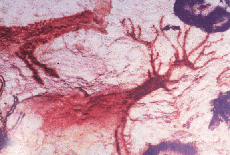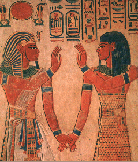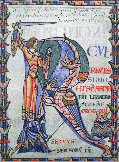

The media we will discuss are:
The materials and techniques selected define the forms of visual expression the artist or designer can develop in their work. The various media offer both distinctive limitations and opportunities for the artist/designer. For this reason we need to look at the media traditionally used in order to understand the context in which visual language evolves. We will do this before we begin to examine the actual styles that have developed historically.
We will discuss many different painting related media:
 The
oldest examples of painting date to more than 20,000 B.C, and can be found in
the caves
in southern France. The best known of these caves is at Lascaux, although
there are many others. These portraits of animals and hunters were probably
done with a mixture of minerals such as ochre, with animal fat used as the medium.
Rock paintings in this technique can be seen in many parts of the world.
The
oldest examples of painting date to more than 20,000 B.C, and can be found in
the caves
in southern France. The best known of these caves is at Lascaux, although
there are many others. These portraits of animals and hunters were probably
done with a mixture of minerals such as ochre, with animal fat used as the medium.
Rock paintings in this technique can be seen in many parts of the world.
 In
the technique known as encaustic,
the medium for the powdered color is hot wax which is painted onto a wood surface
with a brush. It is then smoothed with a metal instrument resembling a spoon,
and then blended and set over a flame to soften and set the colors into the wood.
This method produces durable colors and
permits sculptural modeling of the paint surface. Because of the wax medium,
the colors are semi-translucent and look fresh and lively. This technique is rare
today, but it was practiced in late Roman times; for example, we have burial portraits
from Faiyum, Egypt, 2nd century, A.D.
In
the technique known as encaustic,
the medium for the powdered color is hot wax which is painted onto a wood surface
with a brush. It is then smoothed with a metal instrument resembling a spoon,
and then blended and set over a flame to soften and set the colors into the wood.
This method produces durable colors and
permits sculptural modeling of the paint surface. Because of the wax medium,
the colors are semi-translucent and look fresh and lively. This technique is rare
today, but it was practiced in late Roman times; for example, we have burial portraits
from Faiyum, Egypt, 2nd century, A.D.
 In
the dry plaster or "fresco secco" technique, pigments are usually mixed with water,
although other substances might also be used. The paint is then applied to a dry
plaster wall which has been wetted down with water. Since the plaster is relatively
dry, it is non-absorbent, and the pigment adheres to the surface of the plaster.
This technique differs from true fresco (described below) in several ways. The
colors tend to flake off the surface of the plaster. The colors have a harder
and more brilliant appearance and tend to be lighter in value than those in true
fresco. Advantages of the technique are that the painting can be done more slowly
and carefully, and changes can be made simply by over-painting, since colors are
opaque. Examples: Egyptian
murals, 2500-1000 B.C.
In
the dry plaster or "fresco secco" technique, pigments are usually mixed with water,
although other substances might also be used. The paint is then applied to a dry
plaster wall which has been wetted down with water. Since the plaster is relatively
dry, it is non-absorbent, and the pigment adheres to the surface of the plaster.
This technique differs from true fresco (described below) in several ways. The
colors tend to flake off the surface of the plaster. The colors have a harder
and more brilliant appearance and tend to be lighter in value than those in true
fresco. Advantages of the technique are that the painting can be done more slowly
and carefully, and changes can be made simply by over-painting, since colors are
opaque. Examples: Egyptian
murals, 2500-1000 B.C.
 Fresco, also known as Buon Fresco or True Fresco, entails painting on
freshly spread, moist plaster. First, layers of plaster are applied to the surface.
While the final layer is still wet, the artist applies the colors, which are earth
pigments mixed with water. The colors penetrate the wet plaster and combine chemically
with it, producing a painted surface which does not peel when exposed to moisture.
As the paint must be painted on wet plaster, the amount of plaster which may be
put down at one time is limited to what can be painted at one sitting. Often lines
can be seen in frescos around an area which was one day's work. The painting must
be done rapidly and without mistakes. It produces a mat surface with fairly desaturated
colors. This technique was perfected in Renaissance Italy. Examples include
Roman wall paintings at Pompeii, 1st century A.D ;
Giotto's Arena Chapel at Padua, 14th C.; Michelangelo's
Sistine Chapel ceiling, 16th C.
Fresco, also known as Buon Fresco or True Fresco, entails painting on
freshly spread, moist plaster. First, layers of plaster are applied to the surface.
While the final layer is still wet, the artist applies the colors, which are earth
pigments mixed with water. The colors penetrate the wet plaster and combine chemically
with it, producing a painted surface which does not peel when exposed to moisture.
As the paint must be painted on wet plaster, the amount of plaster which may be
put down at one time is limited to what can be painted at one sitting. Often lines
can be seen in frescos around an area which was one day's work. The painting must
be done rapidly and without mistakes. It produces a mat surface with fairly desaturated
colors. This technique was perfected in Renaissance Italy. Examples include
Roman wall paintings at Pompeii, 1st century A.D ;
Giotto's Arena Chapel at Padua, 14th C.; Michelangelo's
Sistine Chapel ceiling, 16th C.
 In
this method, the pigment is mixed with egg yolk or both the yolk and white of
an egg. It is thinned with water and applied to a gesso ground (plaster mixed
with a binding) on a panel. It was also used on parchment or paper to illustrate
or embellish books in the era before the 15th century development of the printing
press. This type of painting dries very quickly and produces an opaque, matte
surface. The colors tend to dry to a lighter value than they appear when wet.
The colors produced are bright and saturated. Modeling is achieved by hatching.
Egg tempera was used for panel painting until the 15th century. Examples of artists
that worked in egg tempera include Cimabue (14th C.); Duccio (14th C.);
Andrew
Wyeth (20th C.) Islamic and Medieval miniature paintings in books and manuscripts
are another important class of egg tempera paintings; the celtic
Book
of Kells is a well-known early example, as is the Book
of Hours commissioned by the Duc du Berry in the 14th century.
In
this method, the pigment is mixed with egg yolk or both the yolk and white of
an egg. It is thinned with water and applied to a gesso ground (plaster mixed
with a binding) on a panel. It was also used on parchment or paper to illustrate
or embellish books in the era before the 15th century development of the printing
press. This type of painting dries very quickly and produces an opaque, matte
surface. The colors tend to dry to a lighter value than they appear when wet.
The colors produced are bright and saturated. Modeling is achieved by hatching.
Egg tempera was used for panel painting until the 15th century. Examples of artists
that worked in egg tempera include Cimabue (14th C.); Duccio (14th C.);
Andrew
Wyeth (20th C.) Islamic and Medieval miniature paintings in books and manuscripts
are another important class of egg tempera paintings; the celtic
Book
of Kells is a well-known early example, as is the Book
of Hours commissioned by the Duc du Berry in the 14th century.
 The
design is created by small pieces of colored glass, stone, or ceramic (called
Tesserae), embedded in wet mortar which has been spread over the surface to be
decorated. Their slightly irregular placement on a surface creates a very lively,
reflective surface when viewed at a distance. This was often used to decorate
walls, floors, and ceilings. This link takes you to an
gallery of Byzantine
mosaics.
The
design is created by small pieces of colored glass, stone, or ceramic (called
Tesserae), embedded in wet mortar which has been spread over the surface to be
decorated. Their slightly irregular placement on a surface creates a very lively,
reflective surface when viewed at a distance. This was often used to decorate
walls, floors, and ceilings. This link takes you to an
gallery of Byzantine
mosaics.
 |